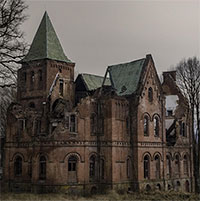The “cloak” is actually an empty wine barrel with a hole to fit the head out. Dating back to 16th century England, the “drunk man’s cloak” was a public punishment for drunken people.
If you’ve ever woken up with a throbbing headache, upset stomach, nausea, and perhaps even regret after a night of drinking, you’ve certainly experienced the consequences of drinking. drunk. People might think those symptoms are too much of a price to pay for getting drunk. But no, authorities in 16th-century England devised another punishment for people who were often drunk: “Drunkard’s Cloak”.

A wooden crate for people who have been repeatedly arrested for drunkenness in the UK. (Photo: Allthatinteresting)
This penalty is quite simple. Anyone convicted of repeated intoxication would have to carry an empty wooden barrel of beer with a hole punched in the top to get his head through. After that, they will be paraded through the street in ridicule and humiliation of everyone.
Drinking culture has always been a part of British history, but the ” drunk cloak” marked a strong protest against the evils of excessive drinking.
The “Drunk Cloak” is also known as “Newcastle Cloak” (Newcastle Cloak). Some historians believe that it was first used as punishment for drunken people in Newcastle upon Tyne, a city in northeastern England.
On History Extra, historian Dan Jackson explains that Newcastle is famous for its drinking culture. “Newcastle was one of the first towns in England to brew beer. And ‘Newcastle hospitality’ was a very popular phrase in the 18th century. This phrase means generously entertaining guests with how to take them out for a great drink “, the historian explains.
The truth is, just like today, hundreds of years ago, people in Newcastle turned to alcohol for reasons like needing to relax after a long day of hard work. At that time, their jobs were often exhausting sessions in coal mines and shipyards instead of sitting in an office for eight hours.
“It’s inevitable that people want a break from hard work. Coal miners and shipyard workers are used to drinking alcohol. Especially sailors. prime ministers – people who have been away for months and come home with a lot of money in their pockets,” historian Jackson said.
The more stressed and tired you are, the more you drink. Of course that won’t prevent some people from drinking too much. Therefore, the government has devised an initiative to prevent “drunkenness”.
Fearing the consequences of excessive drinking, the British Parliament set out to find ways to regulate alcohol consumption across the country. The first step was the passage of the Tavern Act of 1551, which officially made intoxication a civil offence. Furthermore, Congress also enacted some strict regulations to punish alcoholics, especially when they are repeatedly arrested.
Anyone caught intoxicated must pay a small fine of 5 shillings. But if they are arrested many times for being drunk in public, they will be punished more severely and humbly than when they have to carry a wooden crate to parade around the street.
The “cloak” is actually an empty wine barrel with a hole punched out to fit the head out. Sometimes it also includes holes for the arms to stick out.
The unique idea of “drunk man’s cloak” can be traced back to King James I of England. However, it was during the rule of Oliver Cromwell – the famous British military and political leader that the punishment of “drunk cloak” became popular. According to Ancient Origins, Mr. Cromwell does not like evils such as gambling, drinking, dancing …
The bizarre punishment of using the ” drunk cloak” quickly spread outside the UK. In Germany, it became known as the “schandmantel” – cloak of humiliation. In Denmark, the form of punishment. This is called the “Spanish Mantle” – the Spanish mantle, and of course, it quickly crossed the ocean and was introduced to America.

Version of the “drunk cloak” in the US military. (Image: Wikimedia Commons).
Although the “drunk cloak” originated in Europe, it was introduced to America in the 19th century. It was used to punish soldiers during the American Civil War.
One document states: “A poor criminal had to put on a wooden barrel, his head poked out through a hole in the barrel” and “the drunken man wandered in the most shameful manner. , looks like an unhatched chick”.
In another document, in 1863, a captain of the Maine brigade punished two members of his unit after getting drunk, by placing them in a barrel with only a hole cut open to expose their heads. . They walked around town for four hours with a sign saying, “I’m wearing this because I drank too much.” The captain later recounted a soldier who thanked him because since he was put in a barrel, he never drank another drop of wine in his life.
Soldiers during the Civil War could also be forced to “wear” wooden cloaks for theft. Offenders must hide in a barrel of wine with the words: “I am a thief”.
The most interesting thing about the “drunk mantle” is its effectiveness . Relatively milder than other methods of punishment or torture, the “drunk cloak” affects violators more based on public humiliation rather than physical pain. This punishment is often effective in changing a person’s behavior.
However, punishment does not always work . Today’s “drunk robes” have become obsolete and drinking is still common in places like Newcastle. “For better or worse, wine has always been an important part of Northumbrian culture. It was a means of social connection and Newcastle is still considered a party city to this day,” concludes historian Jackson.

